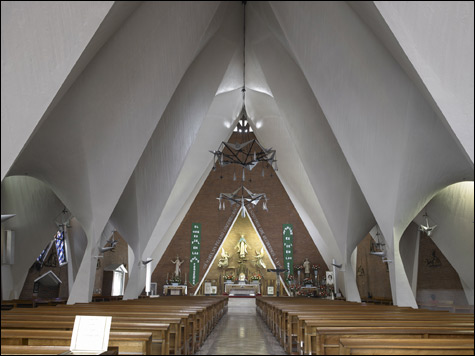
SUBLIME: A series of concrete umbrellas tipped on their sides form the soaring nave of Candela’s Iglesia de la Medalla Milagrosa in Mexico City. |
“Félix Candela: Engineer, Builder, Structural Artist” | MIT Museum, 265 Mass Ave, Cambridge | Through September 27 Gropius House | 68 Baker Bridge Road, Lincoln |
Looking at the wavy roofs of Félix Candela's most iconic structures, like the restaurant Los Manatiales (1958) in Mexico City, I think of pinwheels or the fluttering dress of a spinning dancer. The curves are so graceful, sexy, and gravity-defying that you don't have to recognize the technical marvels built into them to be swept away.But as "Félix Candela: Engineer, Builder, Structural Artist" at the MIT Museum explains, they are engineering feats. Los Manatiales fans four hyperbolic paraboloids — saddle shapes — to span a 106-feet-wide dining area without any support columns. Perhaps what's hardest to believe is that Candela's thin-shell reinforced-concrete roofs are typically just 1.5 inches thick. In comparison, Eero Saarinen's spaceship-like dome for MIT's Kresge Auditorium (1950-'55) in Cambridge — considered the first large-scale concrete-shell building in the US — varies in thickness from 3.5 inches at the apex to 18 inches at the base.
Candela's roofs are so thin that the models here sometimes wind up being three times thicker, by scale, than the actual structures. It seems impossible, and crazy. But after half a century, the structures are still standing.
The exhibit, which was organized by the Princeton University Art Museum, includes design drawings, historical photos, notebooks, and about a dozen models that fill one good-sized gallery. It's a sharp, succinct introduction to Candela, though the limited explanatory texts may leave those without engineering knowledge feeling adrift.
Born in Madrid, Candela (1910–1997) served on the losing side of the Spanish Civil War before arriving in Mexico as a refugee in 1939, just in time for a building boom. His workhorse design was a reinforced concrete "umbrella" resembling a hollow, shallow, upside-down pyramid atop a support column. He deployed these umbrellas in groups, in various sizes, to create sheltered markets (a Mexico City ordinance had abolished open street markets) and train stations. His ingenious solution for the Iglesia de la Medalla Milagrosa (1995) in Mexico City was to tip a series of concrete umbrellas on their sides to form the church's soaring nave.
Cost was one factor that pushed Candela toward concrete. The MIT curators point out that his umbrellas were half the price of similar metal structures. And the catalogue for the Museum of Modern Art's 1955 exhibit "Latin American Architecture Since 1945" argues that Latin America lacked structural timber, produced little structural steel, and manufactured poor-quality brick.
Candela's first parabolic shell structure was the Cosmic Rays Laboratory (1951) at the Universidad Nacional Autónoma de México in Mexico City. It resembles some sort of space tent atop six insect legs. The concrete roof is only 5/8 of an inch thick, to allow the measurement of cosmic radiation. Hidden inside are thicker support ribs. As Candela came to understand the strength of these roofs and grew more confident from building test structures and finished projects for clients, his designs eliminated more and more of these beams.